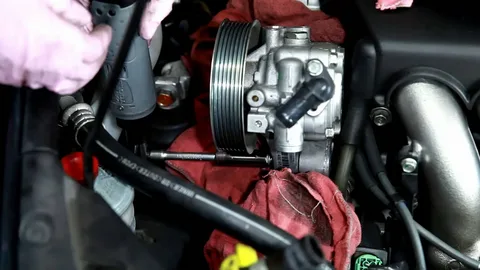When it comes to driving, nothing beats the feeling of gliding effortlessly through turns and corners. If you’ve ever experienced the frustration of a stiff or unresponsive steering wheel, you know how crucial power steering is for a comfortable ride. Enter the Honda Civic power steering pump—engineered with precision and designed for performance; this essential component transforms your driving experience from ordinary to extraordinary. In this blog post, we’ll delve into why opting for a Honda power steering pump isn’t just an upgrade; it’s an investment in reliability, safety, and pure driving pleasure.
Civic Power Steering Pump and its Importance in a Vehicle
The Civic power steering pump supplies pressurized hydraulic fluid to the power steering rack or gear, which assists in turning the wheels with minimal effort from the driver. Without a functioning power steering pump, steering the vehicle would be nearly impossible, especially at low speeds or when making tight turns.
One of the main advantages of choosing a Honda power steering pump is its exceptional durability and reliability. As one of Honda’s flagship models, the Civic has always been known for its longevity and low maintenance costs. This also extends to its power steering pump, which is designed to withstand heavy use and last for years without significant issues. Moreover, thanks to its advanced design and high-quality components, the power steering pump operates smoothly with minimal noise. This ensures a comfortable driving experience without any distracting vibrations or humming sounds.
Increased Fuel Efficiency
One of the standout advantages of a Honda power steering pump is its contribution to improved fuel efficiency. A well-functioning pump allows your vehicle’s steering system to operate with less effort. The engine doesn’t have to work as hard against resistance when you steer, resulting in less energy consumption and better mileage over time.
Drivers often notice a difference, especially during long commutes or frequent city driving, where turning can become more taxing for both the driver and the vehicle. This efficiency helps your wallet and reduces emissions, making it an environmentally friendly choice for eco-conscious car owners. Choosing a Honda power steering pump is about getting more from every drop of fuel while enjoying smoother rides.
Choosing a Power Steering Pump offers numerous advantages, making it a wise investment for any vehicle owner. This essential component ensures a smooth and enjoyable driving experience, from its durability and reliability to its energy efficiency and safety benefits. So, if you own a Honda Civic, prioritize the proper care and maintenance of your power steering pump for optimal performance on the road.
Civic Steering Pump: Improved Steering Control and Handling
When it comes to driving, precision matters. A Civic steering pump plays a crucial role in enhancing your steering control. This component allows for smoother transitions when navigating turns or changing lanes. With the assistance of a well-functioning power steering pump, drivers experience reduced effort while maneuvering their vehicles. The hydraulic pressure improves responsiveness, making tackling tight corners and winding roads easier.
Moreover, this enhanced control translates into greater confidence behind the wheel. Drivers can react quickly to unexpected situations without feeling strained or fatigued from excessive steering effort. The result? A more enjoyable driving experience that keeps you connected with the road. Trust in a Honda power steering pump means embracing reliability and performance whenever you get behind the wheel.
Longer lifespan for other Steering Components
A Honda power steering pump is designed for durability and efficiency. This means not only does it enhance your steering experience, but it also plays a critical role in extending the lifespan of other steering components. When you choose a high-quality Honda power steering pump, you’re investing in a system that reduces wear and tear on tie rods, ball joints, and even the steering rack itself. A consistent flow of hydraulic fluid ensures these parts function smoothly together.
Moreover, less friction translates to decreased heat buildup. Heat can be detrimental to mechanical systems; by minimizing it, each component lasts longer without needing early replacement or repair. This synergy between the pump and other parts leads to fewer instances of unexpected failure or costly repairs down the road. Enjoy peace of mind knowing that your investment in a Honda power steering pump supports an overall healthier steering system.
Role of Honda Civic Power Steering Motor
One of the main functions of the Honda Civic power steering motor is to assist in turning the wheels. The motor receives signals from the power steering control module connected to the steering wheel. These signals tell the motor how much assistance is needed based on the driver’s input through the steering wheel. By providing this assistance, the power steering motor allows drivers to turn their wheels with minimal effort, making it easier to navigate tight turns or maneuver in parking lots. This makes driving more comfortable and reduces strain on the driver’s arms and shoulders, especially during long trips.
Another essential function of the power steering motor is maintaining a constant level of hydraulic pressure within the system. The motor continuously adjusts this pressure based on vehicle speed and engine load, ensuring drivers have consistent and stable control over their vehicle’s direction.
Maintenance Tips for Ensuring Optimal Performance
Maintenance is essential for ensuring any vehicle part’s optimal performance and longevity, including the power steering pump in your Honda Civic. Regular maintenance helps prevent costly repairs and ensures your car runs smoothly and efficiently. In this section, we will discuss some maintenance tips that can help you maintain the optimal performance of your Honda power steering pump.
Check for leaks: One of the most common issues with power steering pumps is leaks. It is essential to regularly check for any signs of leakage, such as low fluid levels or visible puddles under your car. If you notice any leaks, it is crucial to get them fixed immediately to avoid further damage.
Top-up fluid levels: The power steering pump requires a specific fluid type for proper functioning. Check the fluid level at least once a month and top it up if necessary. Low fluid levels can cause excessive strain on the pump and lead to premature wear and tear.
Flush the system: Over time, debris and contaminants can build up in the power steering system, causing clogs and hindering performance. Therefore, it is essential to flush out the old fluid and replace it with new, clean fluid every 30,000 miles or as your manufacturer recommends.
Inspect belts and pulleys: The belts connected to the power steering pump turn the car when you steer it. It is crucial to regularly inspect these belts for cracks or signs of wear and tear. If they are damaged, they should be replaced immediately to avoid further damage to the pump.
Listen for unusual noises: Unusual noises, such as squeaking or whining under your hood, could indicate a faulty power steering pump or related components like belts or hoses. If you hear any strange noises while driving, it is best to get your vehicle inspected by a professional mechanic.
Cost-Effectiveness of choosing a Honda Civic Steering Pump
One of the main advantages of choosing a Honda Civic steering pump is its cost-effectiveness. These pumps are known for their durability and reliability, requiring less maintenance and replacements than other brands. This can ultimately save you money in the long run. Additionally, Honda has a reputation for producing high-quality vehicles with affordable parts. This extends to their power steering pumps as well. The price point for a genuine Honda steering pump may be slightly higher than some aftermarket options, but the quality and longevity make it worth the investment.
Another factor contributing to the cost-effectiveness of choosing a Honda steering pump is its compatibility with other Honda models. If you have multiple Hondas in your household or plan on purchasing another one, having interchangeable parts can save you even more money on repairs and replacements.
Furthermore, using a genuine Honda power steering pump can help prevent potential damage to other components of your vehicle’s steering system. Aftermarket pumps may not always fit perfectly or have the same level of performance as OEM parts, which can lead to issues down the road.
Conclusion
Investing in a Honda Civic power steering pump is a decision that pays off in multiple ways. The smooth handling and improved control enhance your driving experience, making each ride more enjoyable. The added fuel efficiency means you’ll save at the pump while enjoying superior performance on the road. Longevity is another crucial factor; a high-quality Honda power steering pump helps extend the lifespan of other steering components, reducing wear and tear over time. With less frequent maintenance, you’ll find peace of mind knowing that you’re choosing durability and reliability.
FAQS
What Is A Power Steering Pump, And What Does It Do?
A power steering pump is vital to your Honda Civic’s steering system. It generates the hydraulic pressure needed to assist in turning the car’s wheels, making steering easier, especially at low speeds or when making tight turns.
How Do I Know If My Honda Civic Needs A New Power Steering Pump?
A few signs that your power steering pump needs to be replaced include difficulty turning the wheel, whining or groaning noises when turning the wheel, or leaking fluid from under the hood of your car.
How Often Should I Replace The Honda Civic Power Steering Pump?
The lifespan of a power steering pump can vary depending on driving habits and maintenance history. However, as a general rule of thumb, replacing it every 100,000 miles or around every 10 years is recommended.



